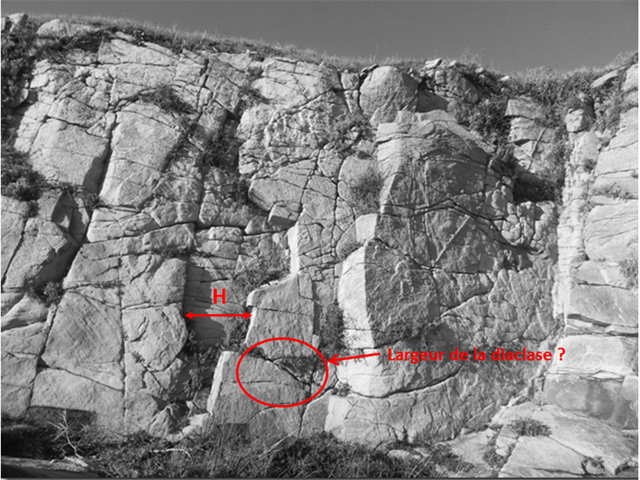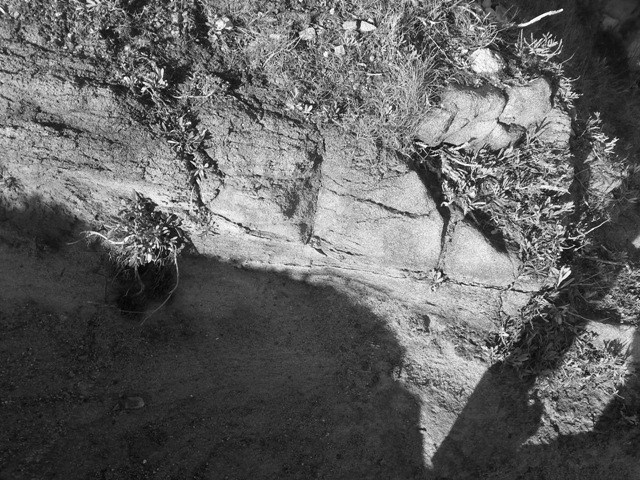La Earhcache / The Earhcache
La « côte sauvage » entre Batz Sur Mer et le Croisic est un lieu remarquable, tant par ses paysages que par sa nature géologique.
C’est également un endroit privilégié pour découvrir la roche plutonique et métamorphique qui compose la base du Massif Armoricain, ainsi que son évolution et sa dégradation au fil des âges.
► Le contexte géologique local
Nous sommes dans un environnement de substrats anatectiques, composés de gneiss nébulitiques et de granite anatectiques, toutes les deux de même composition et datés de 360 millions d’années.

Par recristallisation et homogénéisation progressive, ces roches granitoïdes se sont plus ou moins homogénéisées, avec une certaine richesse en biotite, pour donner une roche granitique à grain fin, riche en feldspaths.
Ces roches, à la limite entre roches métamorphiques (le gneiss) et roches plutoniques (le granite), se sont retrouvées en surface suite aux mouvements orogénétiques varisques, et ont alors entamé leur processus d’altération.
► Les diaclases, accélérateurs de l'altération
Si le granite est une roche dure et résistante, il manque de souplesse. Lors des mouvements de l’écorce terrestre et au cours de son refroidissement le granite se fissure rapidement.
Les fractures apparues (qui portent le nom de
diaclases) facilitent l’altération en
permettant à l’eau de circuler et d’avoir une large surface de contact avec la roche, mais également aux racines des
plantes de pénétrer plus facilement à l’intérieur du substrat.

Sans ces diaclases, le granite, roche très imperméable, ne s’altérerait que difficilement.
► Principes d’altération du granite
Les principaux agents d’altération sont :
• l’eau : elle agit d'un part par hydratation (addition d’eau à un composé sans modification chimique de celui-ci). Chez les micas par exemple, l'eau peut se glisser entre les feuillets du minéral, provoquer son gonflement, ce qui va peu à peu désolidariser les grains de la roche. L'eau agit aussi par hydrolyse (décomposition chimique).
• les végétaux : les racines agissent dans les diaclases et il existe une action des molécules organiques issues de la décomposition de ces végétaux).
Chacun des minéraux du granite réagit différemment à l’altération :
- Le mica noir (ou biotite) : A cause de la présence de fer dans sa composition, il va se transformer assez rapidement en hydroxyde de fer et en argile.
-Le mica blanc (ou muscovite) : Il ne s’altère guère. Il va surtout se fragmenter en petites paillettes de même composition chimique : la séricite.
-Le quartz : Il est inaltérable. Une fois séparé des autres éléments, il fournit l'essentiel du sable.
-Les feldspaths : Par hydrolyse, ils vont se transformer en argiles (illite, kaolinite, gibbsite, smectites…).
► L’arène granitique, résultat de l'altération
Un granite altéré puis « pourri » va se distinguer d’un granite sain par une couleur plus rouille ou jaunâtre, une fragilisation progressive, une surface plus rugueuse et un aspect mat des cristaux de feldspaths.
L’altération se poursuivant, ce granite « pourri » va se désagréger et se réduire à un amas de grains, formant une sorte de sable grossier, l’arène granitique, qui s’accumule à la base de l’affleurement ou entre les blocs de granite non encore altérés.
Cette arène granitique présente la composition suivante :
• grains de quartz non altérés
• grains de feldspaths restants, plus ou moins altérés
• oxydes de fer
• argiles(provenant de l’altération par hydrolyse des micas et des feldspaths)
The "Wild Coast" between Batz Sur Mer and Le Croisic is a remarkable place, both for its landscapes and this geological nature.
This is also a great place to discover the plutonic and metamorphic rock that makes up the base of the Armorican Massif and its evolution and its degradation through the ages.
► The local geological context
We are in an environment of anatectic substrates composed of nebulitic gneiss and anatectic granite, both of the same composition and dated to 360 million years.

By recrystallization and progressive homogenization, the granitoid rocks are more or less homogenized with occurrence of biotite, and give a fine-grained granite, rich in feldspar.
These rocks, on the border between metamorphic rocks (gneiss) and plutonic rocks (granite) were left on the surface following the Variscan orogenetic movements and then started their weathering processes.
► The fracture joints, accelerators of rock alteration
If the granite is a hard and resistant rock, it lacks flexibility. During movements of the earth's crust and during this cooling, the granitic rock cracks quickly.
The fractures occurred (which are called fracture joints) facilitate alteration by allowing water to flow and have a large contact area with the rock but also to plant roots to penetrate more easily inside substrate.

Without these joints, granite, which is a highly impermeable rock, not alter difficulty.
► Principles of the granite alteration
The main alteration agents are :
• Water : it is a hand by hydration (adding water to a compound without there is a chemical modification). In mica for example, water can slip between the sheets of the mineral, causing it to swell, which will gradually separate the grains of the rock. Water also acts by hydrolysis (chemical decomposition).
• Plants : roots act within the fracture joints and there exists an action of organic molecules came from the decomposition of these plants.
Each of the granite minerals react differently to weathering :
- The Black mica (biotite) : Because of the presence of iron in its composition, it will turn quickly enough in iron hydroxide and clay.
- The White mica (muscovite) : It hardly alters. It will mainly fragment into small flakes of the same chemical composition : the sericite.
- The Quartz : It is unalterable. Once separated from the other elements, it provides most of the sand.
- The Feldspars : By hydrolysis, they will turn into clay (illite, kaolinite, gibbsite, smectite ...).
► The granitic arena, result of the alteration
A weathered then "rotten" granite will distinguish healthy granite by from a rust or yellowish color, a progressive weakening, a rougher surface and a matt crystals of feldspar.
The alteration continues, and this "rotten" granite will disintegrate and be reduced to a heap of grains, forming a kind of coarse sand, granitic arena, which accumulates at the base of the outcrop or between not yet altered granite blocks.
This granitic arena has the following composition :
• unaltered quartz grains
• remaining feldspar grains, more or less altered
• iron oxides
• clays (from hydrolysis by alteration of feldspars and micas)
► Sources bibliographiques / Bibliographical sources
Les Questions / The Questions
!!! ATTENTION CACHE UNIQUEMENT ACCESSIBLE MAREE BASSE !!!
!!! WARNING EARTHCACHE ONLY ACCESSIBLE LOW TIDE !!!
Avant de vous y aventurer, consulter l'horaire des marées :
Before you go, check the tide schedule:
Horaires des marées du Croisic
!!! ATTENTION RISQUES DE CHUTE !!!
Soyez très prudent en descendant au pied de la falaise !!
!!! CAUTION RISK OF FALLING, BE CAREFUL !!!
La lecture attentive du descriptif de la cache, ainsi qu'une observation des éléments de terrain et un peu de déduction sont normalement suffisants pour répondre aux questions de cette EarthCache.
A careful reading of the description of the cache, as well as observation of terrain features and some deduction is usually sufficient to answer questions of this EarthCache.
Questions pour valider :"Altération à Batz Sur Mer"
Questions to validate: "Alteration in Batz Sur Mer"
Cette EarthCache vous emmène au pied puis au sommet de la côte sauvage, côte granitique de la presqu'île du Croisic et de Batz Sur Mer.
This EarthCache takes you to the foot and the top of the Wild Coast, granite coast of the Croisic and Batz Sur Mer peninsula.
Point 1 : N 47° 16.190 W 002° 28.273
Vous voici au pied de la falaise ; Approchez-vous en et observez de plus près la roche granitoide et ses diaclases au niveau de la photo ci-dessous.
Here you are at the foot of the cliff ; Come more closely on it and watch the granitoid rock and fracture joints at the photo below.

- Question 1 : Quel est la largeur H entre les blocs de granites à l'endroit où la paroi s’est effondrée ?
- Question 1: What is the width H between the granite blocks at the point the wall collapsed ?
- Question 2 : Observez la diaclase en rond rouge ; quel est son épaisseur ?
- Question 2: Observe the red circled fracture joint ; what is its thickness ?
- Question 3 : Observez la couleur du granitoïde, ainsi que sa dureté avec votre couteau. Comment évaluez-vous son stade de dégradation ?
- Question 3: Observe the color of granitoid and his hardness with your knife. How do you assess its state of degradation ?
Point 2 : N 47° 16.196 W 002° 28.260
Remontez depuis la base de la falaise vers son sommet. A mi-pente, sur votre droite en montant vous pouvez observer la partie supérieure de l’affleurement granitique (voir photo ci-dessous).
Step back from the base of the cliff to the top. Halfway down, on the right amount you can observe the top of the granite outcrop (see photo below).

- Question 4 : Quelle est la couleur de la roche ? Pouvez-vous en enlever un morceau avec vos doigts ? Qu’en déduisez-vous sur son stade de dégradation ?
- Question 4 : What is the color of the rock? Can you remove a piece of it with your fingers ? What do you deduce its stage of degradation ?
- Question 5 : A vos pieds, vous pouvez trouver de l’arène granitique.
Quel est la taille des grains ? Voyez-vous un minéral qui ne semble pas altéré ? D’après sa couleur, quel est la nature de ce minéral ?
- Question 5 : At your feet, you can find granitic arena.
What is the size of the grains ? Do you see a mineral that does not seem altered ? According to its color, what is the nature of this mineral ?
Vous pouvez vous loguer sans attendre notre confirmation,
mais vous devez nous envoyer les réponses par mail en même temps via notre profil (
fafahakkai).
S'il y a des problèmes avec vos réponses nous vous en ferons part.
Les logs enregistrés sans réponses seront supprimés.Une photo de vous ou de votre GPS en Noir et Blanc devant la falaise, ou en couleur vers la mer au sommet de la Côte Sauvage, serait la bienvenue, mais n'est pas obligatoire
You can log this cache without waiting for our confirmation, but you must send us the answers by e-mail at the same time via our profile (fafahakkai).
If there is a problem with your answers we will notify you. The logs recorded without answers will be deleted.
A picture of yourself or your GPS in Black and White in front of the cliff, or in color atop the wild side, would be welcome but is not mandatory.
Rappel concernant les « Earthcaches »: Il n'y a pas de conteneur à rechercher ni de logbook à renseigner. Il suffit de se rendre sur les lieux, de répondre aux questions ci-dessus et de nous renvoyer les réponses.
Reminder concerning "Earthcaches": there is neither a container to look for nor a logbook to sign. One need only go to the location, answer to the differents quiestions and send us the answers.